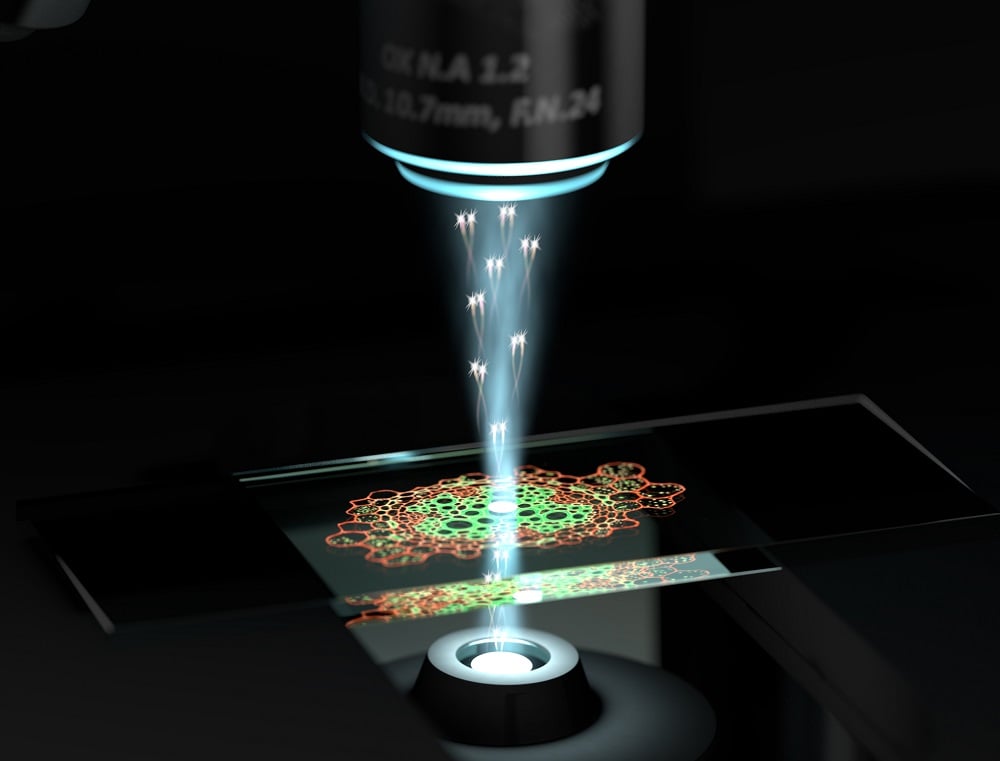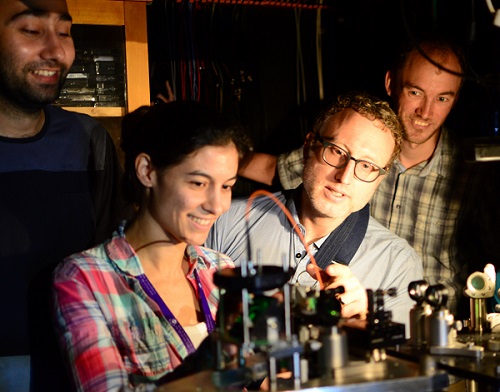A quantum microscope developed at the University of Queensland can resolve cellular structures that would otherwise be impossible to see. The technology overcomes a significant barrier to furthering microscopy for biological imaging.
According to professor Warwick Bowen, who leads the school’s Quantum Optics Laboratory, a major trend in the development of microscopes is the use of intense sources of illumination. A number of precision microscopes use sources that are a trillion times brighter than the sun. Practically speaking, the intensity can’t be increased further as doing so damages the sample being inspected.

Artist’s impression of the University of Queensland’s new quantum microscope in action. Courtesy of the University of Queensland.
“So we need an alternative way to keep improving the performance of microscopes. There are only really two alternatives,” Bowen told Photonics Media.
The first option is to inject a contrast agent like a dye into the specimen, which works well, though it runs the risk of contaminating the specimen, making it sick, or changing its behavior. The other option is to use quantum correlated light to increase the information that the microscope can gather at a fixed intensity, or to reduce the intensity for a fixed amount of information.
Bowen and his team demonstrated the second, showing that quantum correlations can increase performance beyond the limit imposed by photodamage in other microscope configurations.
“In essence, all we do is replace the illumination light source in a precision microscope with a source of quantum correlated light,” Bowen said. “This is challenging because quantum light used previously in imaging has had intensity trillions of times lower than the intensities needed for most precision microscopes.”
He and his team put a great deal of effort into increasing the light intensity while maintaining the quantum correlations. Compared to previous experiments with quantum imaging, the microscope Bowen developed had an intensity 1012 times higher.
“Our quantum light source was a particular kind of light called ‘squeezed light’ that has the special property of having intensity noise lower than is possible with any sort of light that does not have quantum correlations/entanglement,” Bowen told Photonics Media.

University of Queensland researchers (counter-clockwise from bottom left) Caxtere Casacio, Warwick Bowen, Lars Madsen, and Muhammad Waleed aligning the quantum microscope. Courtesy of the University of Queensland.
With this approach, the researchers were able to reduce their noise floor below the level possible with conventional methods, resulting in a level of clarity that wouldn’t have been possible without destroying the sample.
The photons in their light source have strong temporal correlations, meaning that detecting one photon grants information about when the next will arrive, which reduces the stochastic nature of light that introduces noise.
“The challenge now is to boost the enhancement we achieve from a 35% improvement in contrast to higher levels,” Bowen said.
The key innovation was in producing a source of quantum correlated light bright enough for use in precision microscopes.
“Compared to previous quantum imaging experiments, we increase the quantum light intensity by about a trillion times,” Bowen said. “However, in doing so, the quantum correlations became somewhat degraded.”
Weaker light sources not used in microscopy have granted signal-to-noise improvements as high as a factor of 30.
“A key challenge for us is to achieve this sort of improvement with our very bright source of quantum light,” Bowen said. “This would allow us to increase the imaging contrast by the same factor of 30, or alternatively speed up imaging by 30 times.”
Bowen sees the technology finding utility in biosciences, biomedicine, and in the characterization of materials. He would like to see the quantum light source’s performance improved before it’s adopted in those contexts, though he is optimistic about the future.
“There have been many hundreds of proof-of-principle experiments, most at absolute performance levels very far away from the state-of-the-art. Our work shows that quantum sensors can see beyond the practical limits of regular sensors,” Bowen said. “I see this as opening the door to many future applications of quantum technologies, not limited to microscopy.”
The research was published in Nature (www.doi.org/10.1038/s41586-021-03528-w).